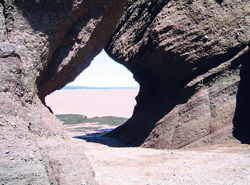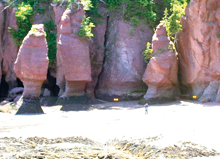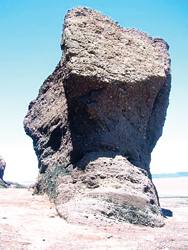Imagine exploring the ocean floor. To discover a landscape, that only a few hours earlier was
submerged by the sea.
At the Hopewell Rocks in New Brunswick, Canada, where one can experience the highest tides in the world, this is exactly what we did.
It is almost noon when we arrive at the shores of the Bay of Fundy, where the rocks are located. Despite the fact that it is the middle of summer, we have to wear coats because of the chilly wind that blows in from the ocean. We walk the gravel trail that goes through the woods to reach one of the most spectacular sights we have ever seen – enormous rocks that have been carved by water, wind and time into strange shapes
towering over us, a vast expanse of muddy beach, covered in seaweed, that will, in a few hours, once more become the bottom of the ocean.
It is low tide as we
scramble down the
staircase that leads to the beach. A warning sign tells us that we have to be back in two hours, before the tide begins to come in.
Apparently, when the tide turns and starts to flow once more, it can rise between six and eight
vertical feet per hour – and a 100-billion tonnes of sea water slowly fills the space that we are now in. This phenomenon takes place everyday, twice a day, and visitors from all over the world come to be awed by this incredible sight. As we explore the caverns and tunnels on the beach, there is much to see and learn about this natural wonder.
What are the Hopewell Rocks?
Also called the Flowerpot Rocks, these are rock formations caused by tidal erosion. The formations are made of dark
sedimentary conglomerate and sandstone rock. The large volume of water
flowing in to and out of the Bay of Fundy transforms the landscape surrounding it.
After the retreat of the glaciers in the region
following the last ice age, surface water filtering through cracks in the cliff has eroded and separated the formations from the rest of the cliff face. Meanwhile, advancing and retreating tides and the associated waves have eroded the base of the rocks at a faster rate than the tops, resulting in their unusual shapes.
How are the highest tides in the world formed?
While the gravitational forces of the sun and moon
combine to
create a range of tidal action the world over, two unique characteristics combine to create the highest tides on the planet at the Bay of Fundy.
One is the unique shape of the Bay. The Bay of Fundy is 290 km in length. The mouth of the Bay is
100 km wide and 120-215 m deep. Described as funnel-shaped, the bay gradually narrows and shallows until it splits to form two
consecutive bays and basins that ultimately split into the Memramcook and Petitcodiac Rivers.
The Hopewell Rocks is found near this junction of rivers. The gradual tapering and shallowing of this body of water constricts the tidal flow into the bay, causing the water to rise from the average high tide of 1 m, found elsewhere in the world, to the 16 m tidal range found at the head of the bay.
The second factor is
resonance. Every basin of water has its own natural rhythm of water movement. The time it takes for the tide to flood the full length of Bay of Fundy is equal to the time it takes for the tide to come in from the adjoining Gulf of Maine.
This resonance effect – the meshing of these two rhythms – amplifies the tidal range, creating higher tides. Called the 'Seiche Effect,' this amplification is often compared to the wave action produced by sloshing water back and forth in a bathtub, each wave higher than the previous one. Because of this, the Bay of Fundy has also been called 'The world's largest
bathtub.'
Legends
The native Mi'kmaq
people, who first knew the tides of the Bay of Fundy better than anyone, had many colourful legends to explain their mystery.
They believed that Glooscap, the great native god, wanted to take a bath. He commanded Beaver to build a dam across the mouth of the bay to trap the high water so that he could bathe. Beaver did as he commanded, but this made a Whale unhappy.
Whale demanded to know what caused the flow of water to stop. Glooscap, not wishing to anger Whale, instructed Beaver to break the dam, but Whale was impatient and began to break the dam apart with his great tail. This caused the water to slosh back and forth with such power that it continues today.
There were also some unlucky people, they said, who were enslaved by angry Whales living in the Bay. There came a time when some tried to escape their captors. They managed to flee as far as the beach, but were captured by the angry Whales, and turned to stone. Their images remain today, encased in the rock
formations on the beach.
|



